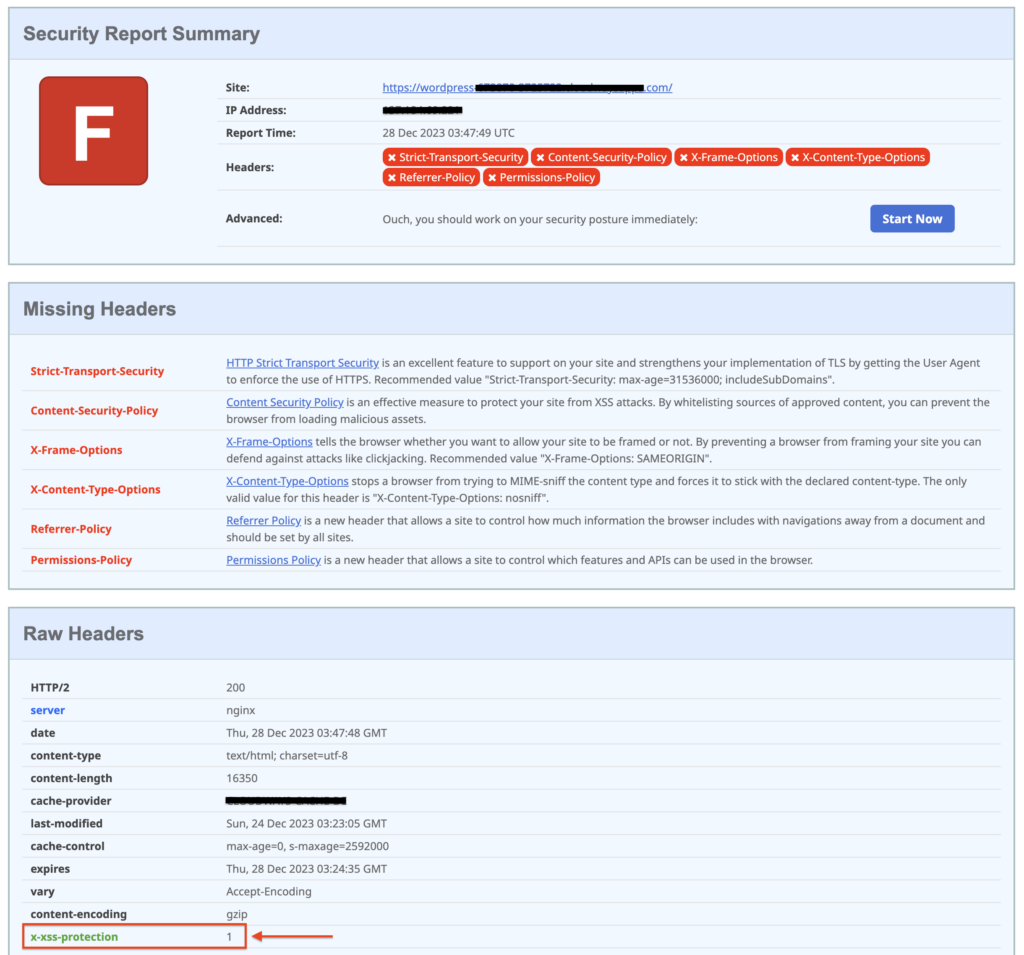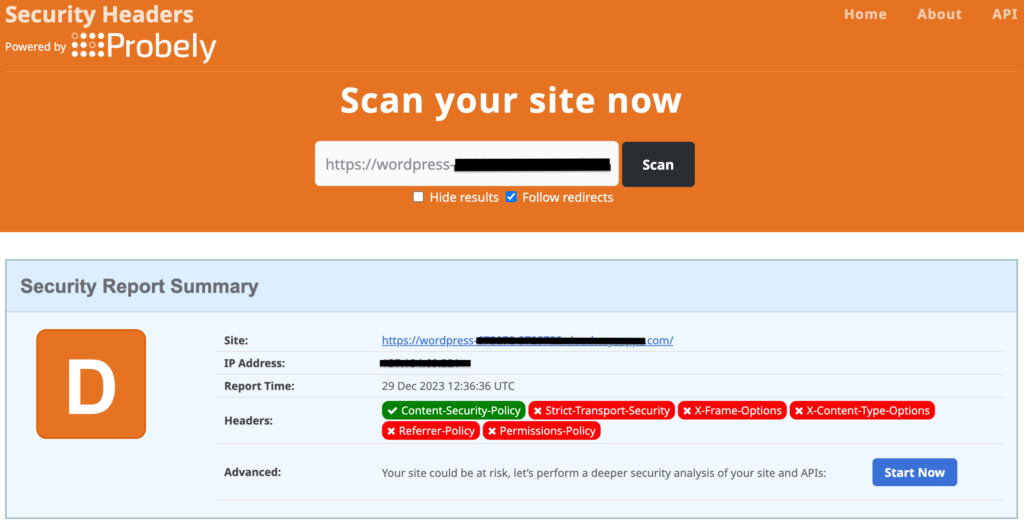What are WordPress Security Headers?
by
7-layers of Security for Your WordPress Site
Your website needs the most comprehensive security to protect it from the constant attacks it faces everyday.

Security headers are an essential tool in the world of WordPress security that often fly under the radar. These powerful lines of code work behind the scenes, quietly standing guard and deflecting sinister online threats. From preventing information theft to blocking sneaky intrusion efforts, security headers are a great line of defense.
TL;DR: WordPress security headers are crucial defenses that block various web threats, from code injections to data theft. These settings act as a digital fortress for your site, tailored to stop specific types of attacks before they happen. But, it’s an incomplete security measure. We recommend that you combine security headers with MalCare. It offers automated scanning, instant malware removal, and a suite of protective features to keep you one step ahead of threats.
1. X-Content-Type-Options (XCTO) Header
The X-Content-Type-Options (XCTO) header in WordPress instructs browsers to avoid guessing the nature of the content they’re processing, a practice known as MIME-type sniffing. This header’s job is to eliminate any ambiguity and make sure the browser doesn’t misinterpret the type of data it’s handling, thereby averting errors in data execution. Activating this header with the “nosniff” option ensures that browsers do not fall victim to assaults that take advantage of MIME-type sniffing confusions.

Understanding and deploying this header is pivotal for WordPress site managers because it’s a line of defense against specific attack vectors. It’s particularly effective in thwarting cross-site scripting (XSS) attacks, which occur when a browser’s misjudgment about a file could potentially lead to the execution of harmful scripts. Turning on the XCTO header bolsters your website’s security infrastructure, ensuring a more protected experience for you and your users.
2. X-Frame-Options (XFO) Header
The X-Frame-Options (XFO) header in WordPress dictates if a web page can be displayed within a frame on the browser. A frame is like a window on one webpage, showcasing a segment of another webpage. Imagine it as a digital showcase, presenting pieces of distinct websites within your site’s layout.

This header adds a crucial security measure to ward off clickjacking, where attackers trick users into clicking something deceptive, compromising their sensitive information, or hijacking their system as they browse your site. With XFO, you can seal off your content, preventing it from being embedded without authorization into other sites or pages.
3. X-XSS Protection Header
The X-XSS-Protection header was designed as a defense mechanism against XSS (Cross-Site Scripting) attacks. It would guide web browsers to clean a page by stripping out the hazardous segments or to block it altogether whenever a potential XSS threat was spotted. This header served as a directive for browsers on how to handle these insidious script attacks.

However, the times have changed, and so has the use of this header. It’s become obsolete with the advent of the Content Security Policy (CSP) header, which is a more sophisticated and blanket approach to security that guards against a plethora of web threats, including XSS. Modern browsers are phasing out the X-XSS-Protection header in favor of CSP, which provides stronger and more versatile protection. Nonetheless, for those accessing the web through older browsers, this header may still offer an extra layer of security—a consideration for maintaining cross-browser compatibility and extending protection to a wider audience.
4. Content Security Policy (CSP) Header
The Content-Security-Policy (CSP) header is a robust set of instructions that directs a browser to load and execute resources on your WordPress site only from specified, trustworthy origins. This proactive security feature is a shield against a multitude of threats, such as Cross-Site Scripting (XSS) and invasive data injections, and it helps prevent unsanctioned tampering with your site’s content.

When you implement a strict CSP, you’re essentially giving the browser a whitelist of acceptable sources and asking it to ignore everything else that doesn’t comply. This forward-thinking strategy is a cornerstone of today’s web security practices and is particularly significant for WordPress websites. The popularity of WordPress, coupled with its array of plugins and themes, can be a breeding ground for security gaps, and a stringent CSP helps close those loopholes.
5. HTTP Strict-Transport-Security (HSTS) Header
The HTTP Strict Transport Security (HSTS) header acts as a strict rule for browsers, insisting that they interact with your WordPress site solely via HTTPS. It complements your site’s valid SSL certificate—a necessity for HTTPS access—guaranteeing that all data passing between your site and browsers stays encrypted. Moreover, it defends against cyber threats such as man-in-the-middle attacks, unwanted protocol downgrades, and cookie hijacking. Deploying HSTS is a vital move for preserving the integrity and confidentiality of user data as it flows back and forth from your website.

6. Referrer-Policy Header
The Referrer-Policy header plays a strategic role in fortifying WordPress site security. It tells a browser what kind of referral data—information about the origin of your site’s visitors—it should divulge when navigating from your site to another.

Each time a link is clicked on your website, this header gives a cue to the browser regarding how much referral information to pass on to the target page. Depending on your settings, this could be the complete URL, just the domain, or in some cases, no information at all. The objective is to find the right mix: leveraging referral information for analytics and tailored experiences, while also safeguarding user privacy and security. It’s akin to choosing what details to give someone about your whereabouts—maybe you mention your neighborhood, only the city, or perhaps you prefer to give no details and maintain your privacy.
Why do we need security headers in WordPress?
HTTP security headers are crucial for your WordPress site’s security and performance. Here’s a breakdown of their benefits:
- Strengthening security: Adding CSP and XFO headers to your site can help fend off XSS attacks and malicious code injections.
- Enhancing performance: Cache headers tell browsers how to store content, speeding up page loads.
- Preventing MIME type confusion: XCTO headers ensure browsers identify content types correctly, blocking dangerous content executions.
- Enforcing encryption: HSTS headers secure data in transit, encrypting communications between browsers and servers.
- Safeguarding privacy: Set headers to fine-tune data sharing in web requests, providing greater privacy control.

Security headers are not enough for WordPress security
Securing your WordPress site goes beyond understanding HTTP security headers. A multi-layered security strategy is necessary for strong protection:
- Comprehensive security with MalCare: Utilize MalCare for its strong firewall, malware scanning and cleaning, and bot protection.
- Stay updated: Keep WordPress core, themes, and plugins up-to-date to patch vulnerabilities and improve security.
- Ensure login security: Use complex passwords and enable two-factor authentication to protect against unauthorized access and brute force attacks.
- Regular backups: Set up regular backups with BlogVault for quick site restoration and reduced downtime in case of issues.
- Manage user access: Carefully control user roles and permissions to limit access to content and prevent unauthorized site changes.
- Tighten file permissions: Enforce strict file permissions to control who can alter or view your site’s critical components and data, helping to prevent unauthorized changes or data breaches.
Final thoughts
Implementing WordPress security headers is a significant step in tightening your website’s defense. By setting these headers, you not only shield your site from attacks but also boost its performance and maintain user privacy. Remember, while headers are an important piece of the security puzzle, they work best as part of a comprehensive security strategy.
To enhance your site’s security posture, consider using MalCare. It provides a robust firewall, malware scanning, and automated cleanups, giving you a proactive edge against digital threats. By coupling security headers with MalCare’s protective features, you can create a more secure and reliable online experience for you and your users.
FAQs
How do I implement security headers in WordPress?
You can add security headers by modifying your website’s .htaccess file or by using plugins like HTTP Headers that are designed to manage headers for you. Remember to always back up your website before making such changes.
Can security headers impact my website’s performance?
Yes, certain security headers, like caching headers, can improve performance by optimizing how browsers cache and retrieve your site’s content.
Do security headers affect SEO?
Security headers do not directly affect your site’s SEO. However, they make the user experience secure and trustworthy for visitors to your site. This, in turn, helps search engines like Google rank your content higher up in search results.
Will adding security headers guarantee my website’s security?
No single measure can guarantee 100% security, but adding security headers significantly strengthens your site’s defenses as part of a comprehensive security strategy.
Are there any common issues when implementing security headers?
If not configured correctly, security headers can interfere with the proper functioning of your website. It is advisable to test changes in a development environment first.
Should I still use a security plugin if I have set up security headers?
Yes, security headers and security plugins like MalCare serve different purposes and work best when used together for layered security.
Can security headers protect against DDoS attacks?
While they are not a solution for DDoS protection, properly configured headers can contribute to a more secure environment.
How do I know if my WordPress security headers are working correctly?
You can use online tools like Security Headers that scan your website’s headers to check for proper implementation.
Category:
Share it:
You may also like

MalCare Ensures Unmatched Protection Against User Registration Privilege Escalation Vulnerability
Imagine discovering that your WordPress site, which should be secure and under strict control, has suddenly become accessible to unauthorized users who have the same administrative powers as you. This…

MalCare Ensures Proactive Protection Against WP-Members XSS Vulnerability
MalCare continues to protect its customer sites from all kinds of attacks, even the ones exploiting zero-day vulnerabilities. The recent stored cross-site scripting (XSS) vulnerability found in the WP-Members Membership…
![Top 9 ManageWP Alternatives To Manage Multiple Sites Easily [Reviewed]](https://www.malcare.com/wp-content/uploads/2022/12/malcare-default-image.jpeg)
Top 9 ManageWP Alternatives To Manage Multiple Sites Easily [Reviewed]
ManageWP is a popular name in the WordPress maintenance plugins market. People love how much you get for a free plan, how easy it is to set up, and how…
How can we help you?
If you’re worried that your website has been hacked, MalCare can help you quickly fix the issue and secure your site to prevent future hacks.

My site is hacked – Help me clean it
Clean your site with MalCare’s AntiVirus solution within minutes. It will remove all malware from your complete site. Guaranteed.

Secure my WordPress Site from hackers
MalCare’s 7-Layer Security Offers Complete Protection for Your Website. 300,000+ Websites Trust MalCare for Total Defence from Attacks.








